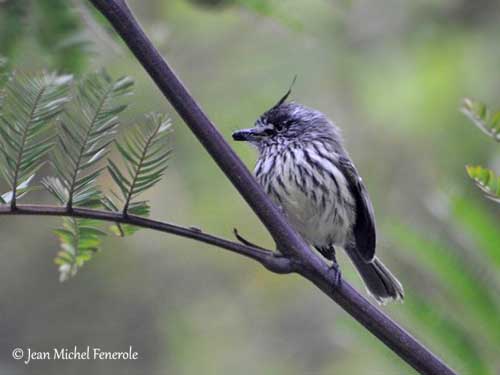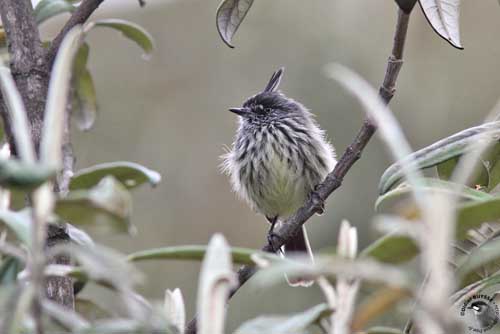
Fr: Taurillon mésange
All : Meisentachurityrann
Esp: Cachudito Piquinegro
Ital: Tiranno dal ciuffo
Nd: Pluimmeestiran
Sd: Gulögd mestyrann
Photographers:
Didier Buysse
Vision d’Oiseaux
Jean Michel Fenerole
Photos d’Oiseaux du monde
Text by Nicole Bouglouan
Sources:
HANDBOOK OF THE BIRDS OF THE WORLD Vol 9 - by Josep del Hoyo - Andrew Elliot - David Christie - Lynx Edicions - ISBN: 8487334695
BIRDS OF SOUTH AMERICA – Passerines - by Robert S. Ridgely and Guy Tudor – HELM Field Guides – ISBN: 9781408113424
A GUIDE TO THE BIRDS OF COLOMBIA by Steven L. Hilty and William L. Brown - Princeton University Press – ISBN 069108372X
BirdLife International (BirdLife International
Wikipedia, the free encyclopaedia
Tufted Tit-Tyrant
Anairetes parulus
Passeriforme Order – Tyrannidae Family
BIOMETRICS:
Length: 9,5 – 11 cm
Weight: 6 g
DESCRIPTION:
The Tufted Tit-Tyrant belongs to the subfamily Elaeniini within the family Tyrannidae. The species of genus Anairetes are named “Tit-Tyrants” because their active foraging behaviour is similar to that of numerous Paridae tits and titmice.
The adult of nominate race has dark grey upperparts with blackish wings. Wing-coverts show narrow white tips forming two indistinct wingbars. The secondaries are finely edged pale yellow, mainly on the innermost flight feathers. The tail is blackish with whitish edges on outermost pair of rectrices, and whitish tips on other tail feathers.
On the underparts, head sides, throat and breast are white and finely streaked blackish. Streaks are narrower on lower breast and upperbelly, but extend down to flanks. The background becomes yellowish to pale yellow from lower breast to belly and undertail-coverts.
On the head, the crown is blackish with black elongated central feathers forming thin, recurved crest. There is a small white crown patch, often concealed and sometimes absent. The forehead is dark grey and lores are black. The supraloral area and the postocular stripe are white.
The bill is black. The eyes are whitish to pale yellow. Legs and feet are black.

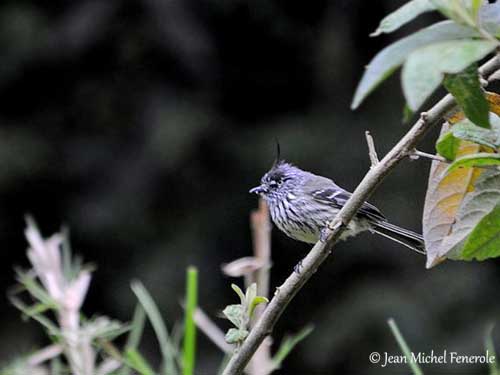
Both sexes are similar.
The juvenile has duller plumage and shorter crest. The white crown patch is absent and wingbars are pale buffy.
We can find three subspecies:
A.p. aequatorialis (here displayed) is found in the Andes from S Colombia to W Bolivia and N Argentina.
This race is slightly browner above. The pale wingbars are better defined. On the underparts, the dark streaks are broader and more extensive.
A.p. parulus (here described) occurs in W Chile and SW Argentina, S to Tierra del Fuego.
A.p. patagonicus is found in W Argentina.
This one is paler grey overall with greyer crown. The white wingbars are broader and more distinct. Streaking on underparts is broader and more extensive against paler yellow to whitish background.
VOICE: SOUNDS BY XENO-CANTO
The Tufted Tit-Tyrant is very vocal. It utters a loud, high-pitched song, chatters and fast phrases “chuit-chuit-chuit-chuit-chuit-chidi-didi” sometimes uttered in duets. It also produces slower series of “chuit” notes. The contact call is a thin “pluit-pluit” and we can also hear a soft, plaintive “pee-de-dit”.
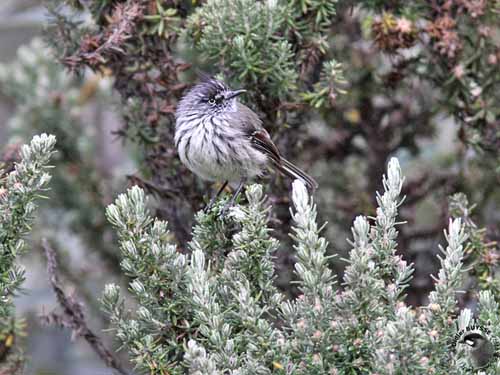
HABITAT:
The Tufted Tit-Tyrant often frequents shrubby clearings and borders of upper montane forests in the Andes. It can be found in brushy forest with bamboo, cloud forest edges, Polylepis woodland, temperate forest, humid scrub and dry thorn-scrub.
According to the range, this species can be seen from sea-level up to 4200 metres in C Andes, but usually between 1800 and 3500 metres of elevation, up to the treeline.
RANGE:
See above in “subspecies”
BEHAVIOUR:
The Tufted Tit-Tyrant feeds mainly on insects. This tiny bird is very active while foraging in pairs or family groups. It gleans like tits and titmice of family Paridae, performing short flights from perch to perch in shrubs. It gleans by perching and hovering from vegetation, flowers and twigs. It also sallies sometimes into the air.
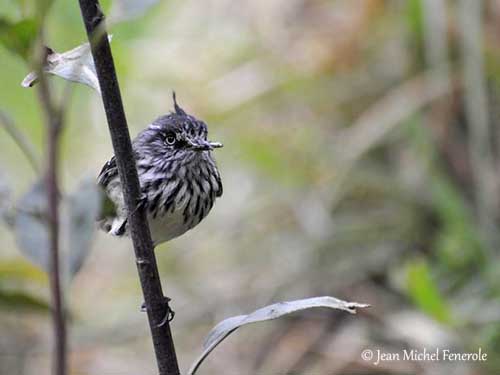
This very active bird often flicks the tail upwards while foraging with shivering wings, often moving, turning and pivoting on its perch.
It may very occasionally feed with other species such as Thorn-tailed Rayadito, but this behaviour is rare. When feeding in pairs, both birds maintain constant visual contact between them. It feeds at all levels, from the forest floor to the canopy.
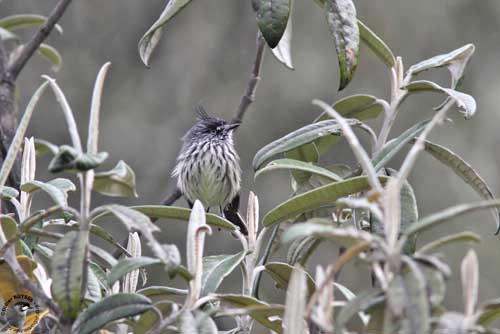
The Tufted Tit-Tyrant is territorial and defends its feeding area against birds of its own species. Defence displays can be performed by one bird or the pair. They call rapidly and raise their conspicuous crest. Intruders are chased through the shrubs and some fights may sometimes occur.
During the breeding season, the male becomes more aggressive. It chases rivals away from its territory, performing an undulating flight and producing whirring sounds. The crest is raised and spread, in order to expose the white crown patch.
The Tufted Tit-Tyrant of the southern range of race “patagonicus” migrates northwards to N Argentina during austral winter after the breeding season.
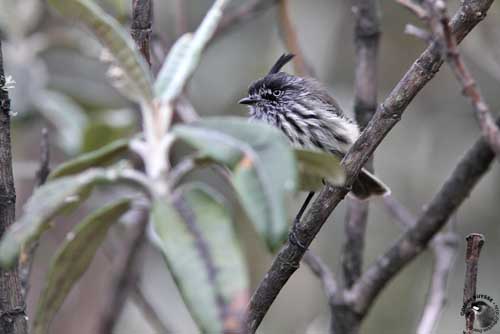
FLIGHT:
The Tufted Tit-Tyrant gleans insects from vegetation by hovering and flycatching. It performs undulating flight when chasing intruders away from its territory.
REPRODUCTION:
The Tufted Tit-Tyrant breeds between January and June in northern range and between August and January in southern regions. This species produces two broods per season.
The nest is placed in shrubs or bamboo, usually near clearing, path or stream. It is a small, compact cup made with grass, lichens, root fibres and plant down. The inner cup is thickly lined with small feathers.
The female lays 2-3 creamy-white unspotted eggs. Incubation and fledging periods are currently unknown.
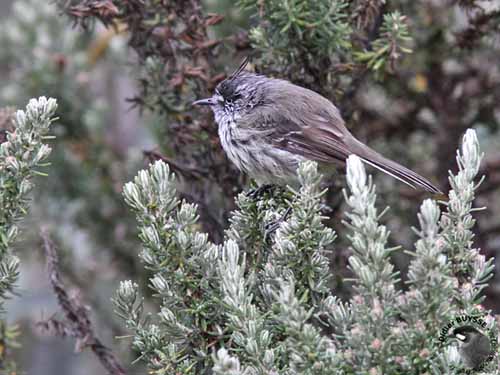
DIET:
The Tufted Tit-Tyrant is an insect-eater. It feeds by perching, hovering and flycatching, always very actively.
PROTECTION / THREATS / STATUS:
The Tufted Tit-Tyrant is found in several protected areas, and is uncommon to locally common throughout the range.
This species is not currently threatened.
